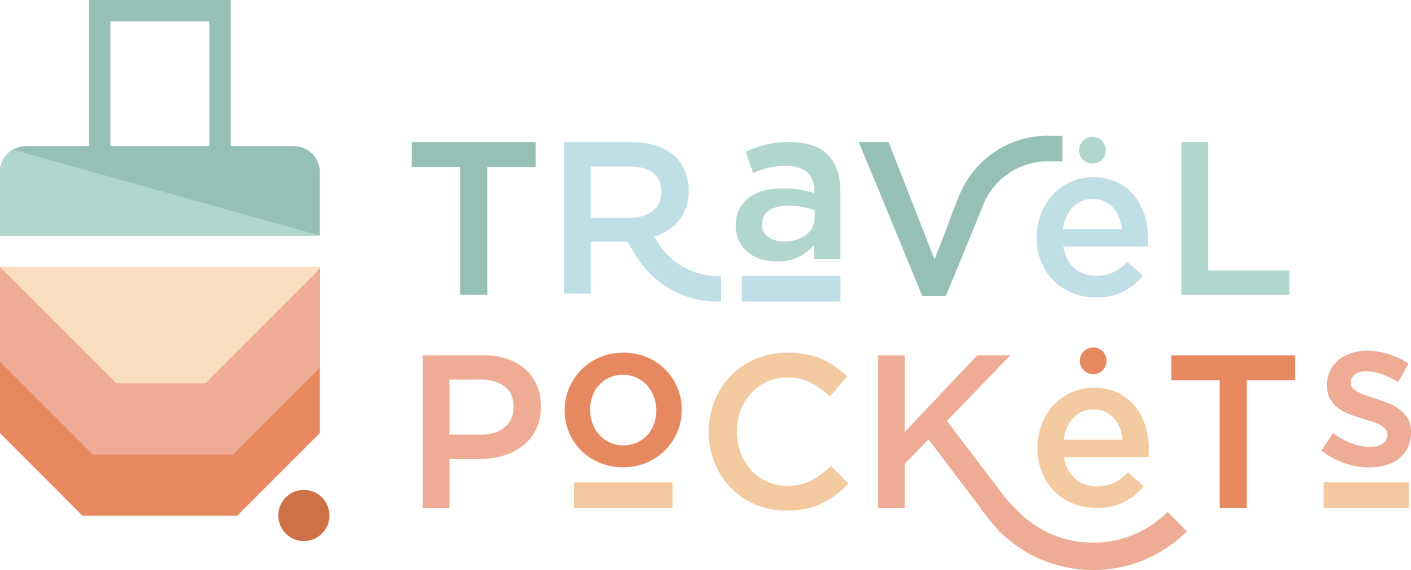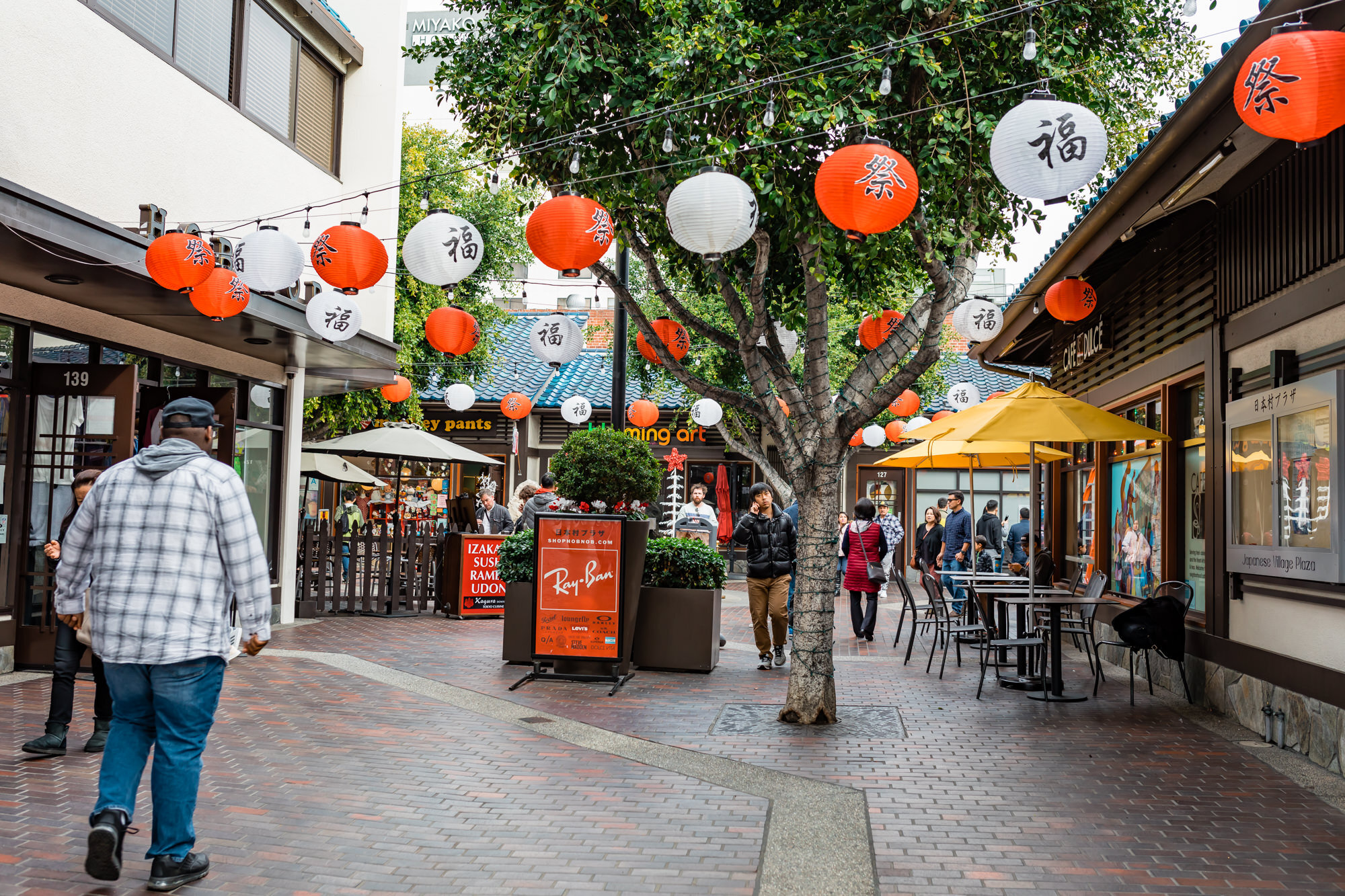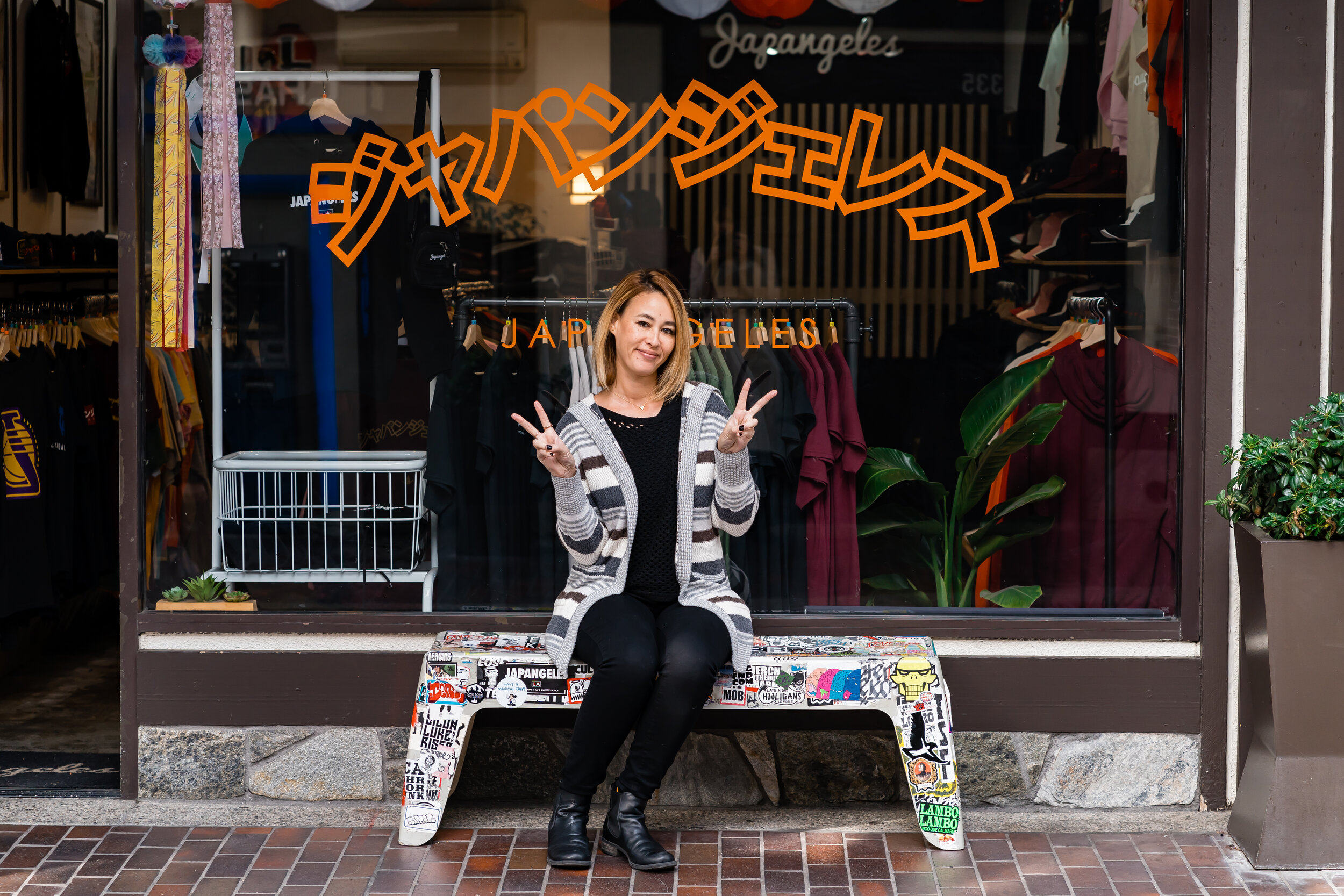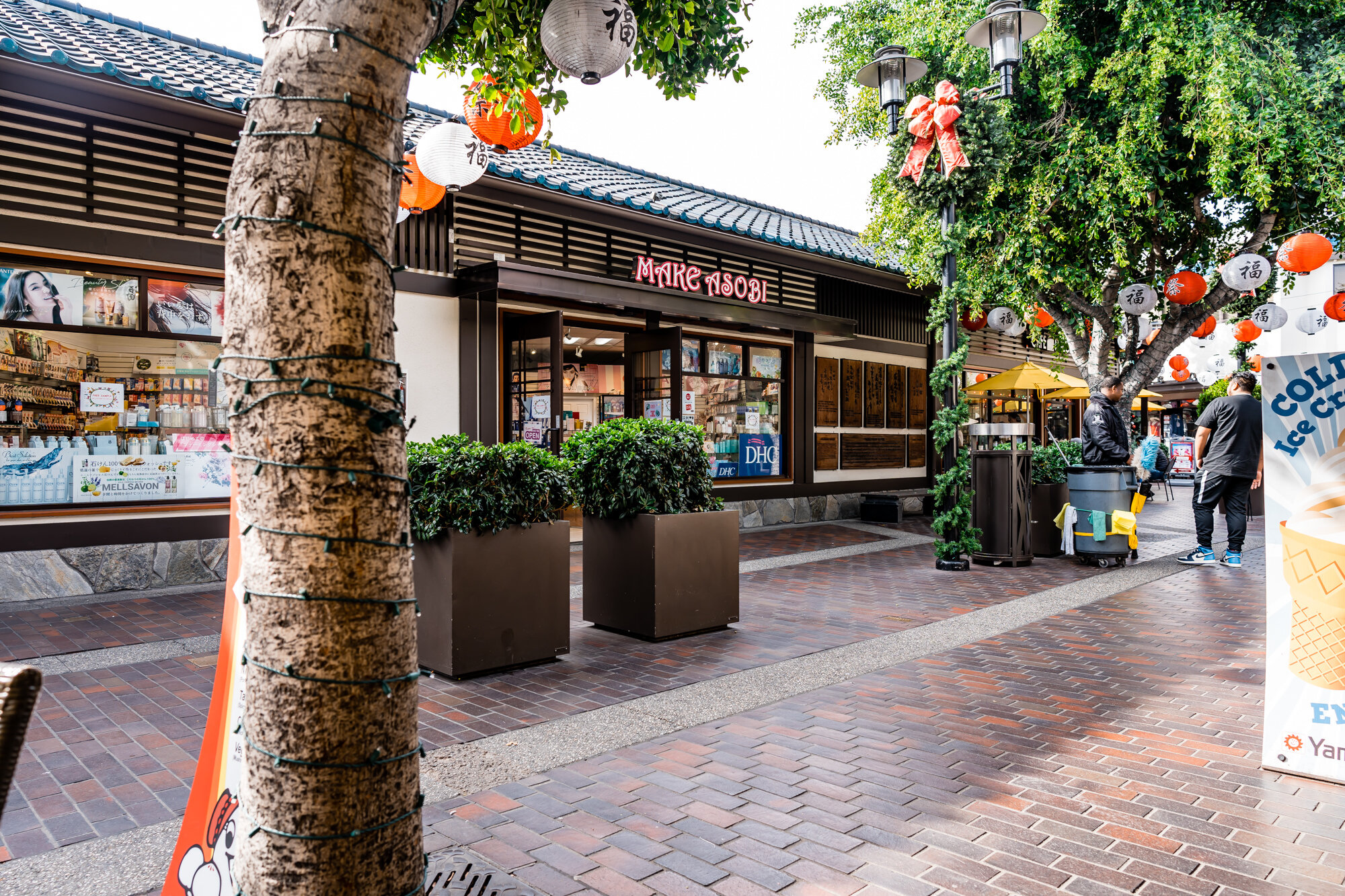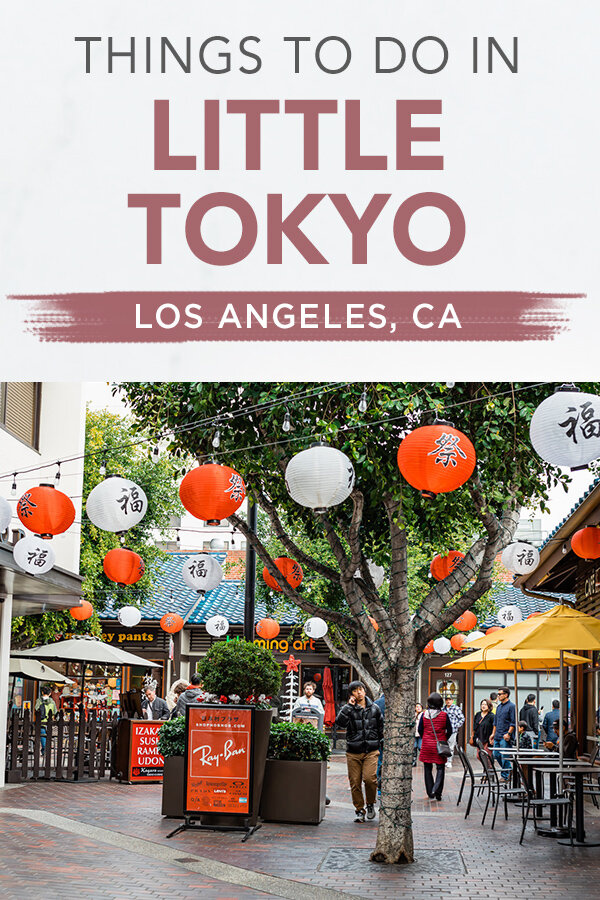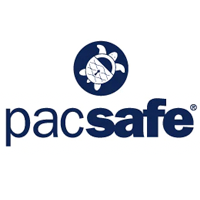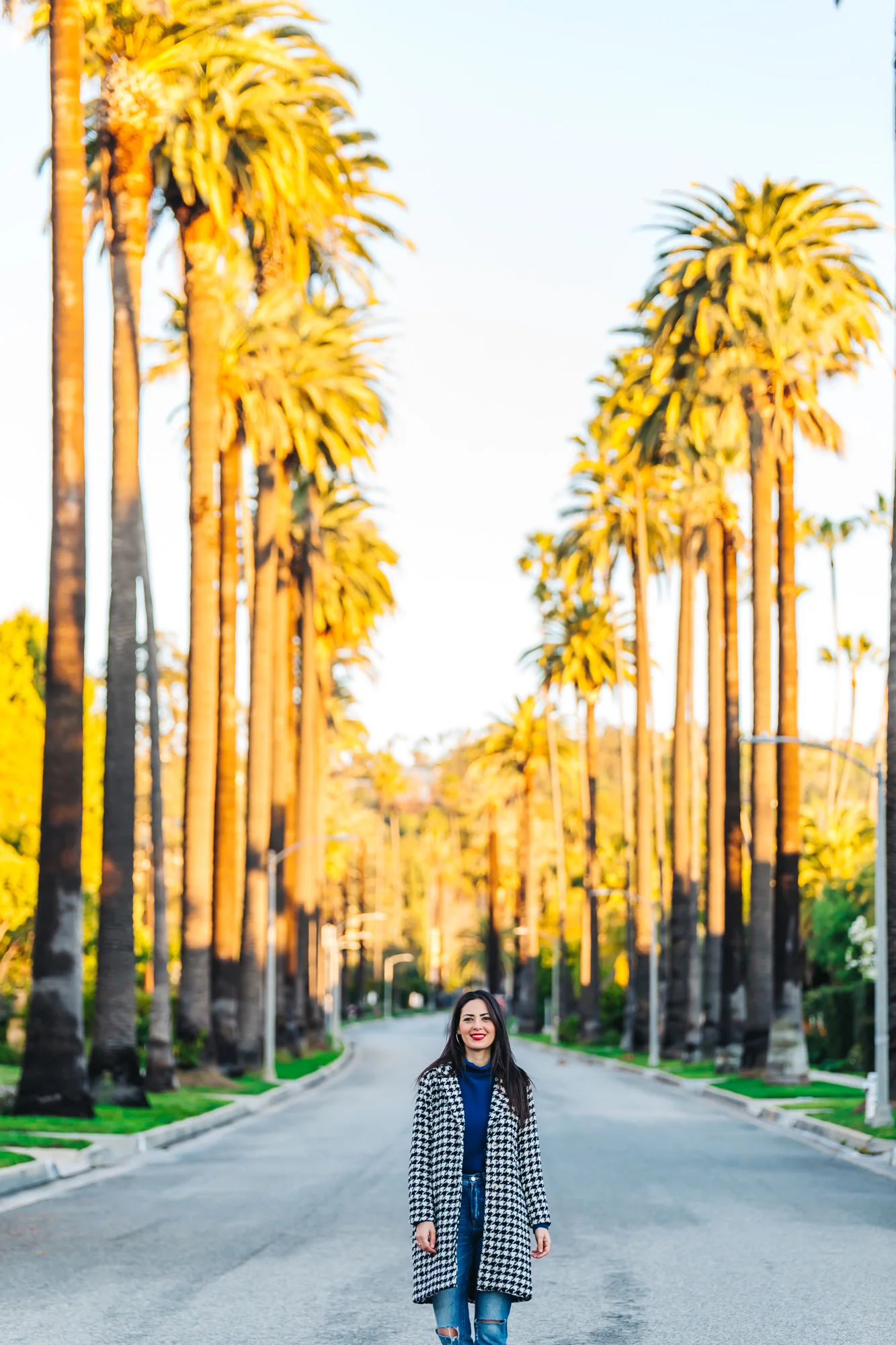Why You Need to Experience Little Tokyo on Your First Visit to Downtown Los Angeles
/This post contains affiliate links, which means that at no additional cost to you if you click on one of the product links, we may earn a commission.
If you are visiting Downtown Los Angeles for the first time, you’ll definitely want to stop by one of the largest official Japantowns in the nation. You can indulge in a freshly baked Melon Pan, tour the largest Japanese American Museum in the U.S., and take home a bunch of Japanese goodies from Nijiya Market.
LITTLE TOKYO HISTORY
Japanese Village Plaza in Little Tokyo Downtown Los Angeles
Little Tokyo Downtown Los Angeles
The roots of Little Tokyo go back pretty far dating to the late 19th century, so it’s a pretty major district for the Japanese Americans living in Southern California. The area was first settled in 1885 and before WWII, Little Tokyo was thriving and it quickly became the largest Japanese community in the United States.
Of course, after the bombing of Pearl Harbor, this all changed drastically and many Japanese Americans were kicked out of their community and forced to live in military-style camps such as Manzanar. After the war, it took some time for Little Tokyo to rebuild and today it is a National Historic Landmark.
BEST TIME TO VISIT
If you want to beat the crowds, we suggest arriving when the shops and restaurants first open. If you want to eat at the popular ramen shops, you’ll definitely want to prepare to either arrive before opening or wait in long lines. Restaurants are popular both during the day and in the evenings. If you want to see the neighborhood at its liveliest, visit during one of their events.
Japanese Village Plaza in Little Tokyo Downtown Los Angeles
FOODIE PARADISE
Growing up in Japan, we’ve purchased plenty of bread from Yamazaki. You don’t even have to go to the flagship store itself as you can find Yamazaki bread at convenience stores and supermarkets all over Japan. Needless to say, if you ask anyone who is Japanese, they will most likely know of the bakery brand Yamazaki.
Melon Pan from Yamazaki Bakery
We mainly stop by Yamazaki Bakery to get a freshly baked Melon Pan. Melon Pan is very popular in Japan and you’ll almost never find it at an American bakery. As a matter of fact, we’ve never been able to find Melon Pan at a bakery store in the U.S. unless it is a Japanese bakery.
Never heard of Melon Pan? It tastes nothing like melons and in fact, the recipe doesn’t even call for melons. It’s a sweet bread covered in a thick layer of cookie crust on top. Sounds amazing right? That crispy top layer is so addicting and only crispy when it’s fresh, so if you get one that isn’t fresh, then you are not getting the best Melon Pan experience.
Yamazaki Bakery
There are also other yummy baked goods here like a gourmet loaf of bread and Japanese cakes. We always end up buying more carbs and sweets than we need, but we just can’t resist.
LOCATION: 123 Japanese Village Plaza Mall (MAP)
COST: Melon Pan: $1.80 | Coffee $1.28 | Tea $1.10
T.O.T. Restaurant
This is a great stop for lunch or dinner if you don’t want to wait in line. When we initially went to Little Tokyo, we wanted to have our favorite ramen at the popular Daikokuya Ramen, but the line was ridiculously long and we didn’t want to wait that long.
Luckily, we were able to find T.O.T. Restaurant with no lines and we were able to get a seat immediately. We were a bit skeptical at first that the restaurant was a little empty, but they had 835 Yelp reviews with 4.5 stars and the reviews were spot on. We both really enjoyed our meals here.
Zaru Soba Teishoku with Shrimp Tempura
Teishokuya of Tokyo (東京定食屋) is what T.O.T. stands for and teishoku is a type of Japanese set meal, where all of the dishes in the course are served together as a set. These types of restaurants usually serve some of our favorite Japanese comfort foods like katsu and that is exactly what Crystal ordered.
Candy ordered the Temzaru Soba Teishoku and the tempura shrimp and veggies were perfectly fried to a crispy golden crunch.
Yummy Shrimp Tempura
Chicken Oroshi Cutlet
I’ve been to dozens of Japanese restaurants in the U.S. and getting the perfectly fried batter of tempura is quite difficult to achieve. The ingredients are super simple, but the key is to use ice-cold water for the batter. I went a little off-topic, but as you can tell, I was very impressed with their tempura here.
LOCATION: 345 E 2nd St. (MAP)
COST: Temzaru Soba $15 | Chicken Oroshi Cutlet $17 | Hot Tea $0
Nijiya Market
If you want a glimpse of what a Japanese supermarket looks like, pop your head into Nijiya Market. We usually save the market for last as we knew we are going to stock up on food and snacks here.
If you want authentic Japanese ingredients or snacks, this is the place to shop as it closely resembles supermarkets in Japan.
Shopping for Ornamin C and barley tea in the beverage aisle
Candy’s favorite mochi on sale
Crystal always buys a bunch of snacks like seaweed potato chips and chocolate (FYI: Japanese chocolate tastes completely different from American chocolate).
Candy purchases healthier items like tofu, burdock root, condiments, and more. To be fair, Crystal has to fly back to Florida, so she doesn’t have the luxury of buying fresh produce.
LOCATION: 124 Japanese Village Plaza Mall (MAP)
Crystal super happy to have found her favorite seaweed chips at Nijiya
Kura Revolving Sushi Bar
If you are a sushi lover and want to experience the revolving sushi bar, Kura Sushi is a popular chain both in the U.S. and in Japan. We’ve dined at a Kura Sushi in Japan and the prices are very reasonable for the quality of food you get.
Kura Revolving Sushi Bar in Little Tokyo
They are known for their natural ingredients and their secret vinegar recipe (vinegar is an ingredient used in sushi rice). This is another restaurant where we saw lines out the door, so we imagine the wait time is pretty long.
LOCATION: 333 E 2nd St. (MAP)
Fugetsu-Do Confectioners
This 116-year old shop specializes in mochi, which is Candy’s ultimate sweet addiction. The mochi is made in-house and the family business has been passed down for three generations and counting.
It’s amazing that this store survived both the Great Depression and World War II. If you have never had the pleasure of tasting a chewy mochi, you must try it at Fugetsu-Do Confectioners.
LOCATION: 315 E 1st St. (MAP)
BOUTIQUE SHOPS
Pop Killer
There are a ton of fun shops here and if you’ve never been to Japan, you can get a little taste of kawaii (cute) Japanese goods here. We popped into Pop Killer and it reminded us of a super mini version of stores in Harajuku: funky vintage apparel and accessories with a sprinkle of kawaii novelty goods.
LOCATION: 343 E 2nd St. (MAP)
Pop Killer
Inside Pop Killer
Kawaii kitty coin purses
Japangeles
This shop was founded by an Angeleno native in 2009 by Roy Kuroyanagi. Most of the apparel at Japangeles is streetwear and it’s a hybrid of traditional Japanese and Southern California aesthetics. You can’t buy this unique apparel online, so the only way to get your hands on it is to make a trip to Little Tokyo.
LOCATION: 141 Japanese Village Plaza Mall (MAP)
Japangeles, Little Tokyo, Los Angeles
Make Asobi
If you are a fan of Japanese cosmetics, Make Asobi has a pretty decent selection of Japanese bath and beauty products. They carry popular cosmetic brands like Shiseido and Shu Uemura.
We were surprised to see our favorite Steam Eye Mask being sold here! These are not only great for travel but for any day when you need to unwind and pamper your eyes.
LOCATION: 130 Japanese Village Plaza Mall (MAP)
Make Asobi in Little Tokyo, Los Angeles
THE JAPANESE AMERICAN NATIONAL MUSEUM
Our main reason for visiting Little Tokyo was to visit the Japanese American National Museum. One year, we took an unconventional California road trip and visited the Manzanar National Historic Site. Manzanar was one of the internment camps that the Japanese Americans were forced to dwell in during WWII shortly after the bombing of Pearl Harbor.
This really hit home for us and couldn’t help but think, “What if this happened to us?”. These American citizens must have been so terrified. Ever since that visit, we’ve been wanting to learn more about the Japanese American culture in depth and this was the perfect place.
The Japanese American National Museum in Little Tokyo is the largest Japanese American Museum in the nation and it sheds light on the internment camps during WWII, as well as, the 130-year history of Japanese-Americans in the United States.
The Japanese American National Museum in Little Tokyo Los Angeles
George Takei (hello, Star Trek fans!) serves as a member of the museum's board of trustees and he and his family were forced to live in the internment camps and were sent to two different ones: Rohwe War Relocation Center (Arkansas) and Tule Lake War Relocation Center (California).
Display of suitcases the Japanese carried to their concentration camp
Very disturbing articles during WWII
Exhibition: Under a Mushroom Cloud: Hiroshima, Nagasaki, and the Atomic Bomb
It always breaks our hearts to think about the unconstitutional acts that the Japanese Americans endured during WWII and how it destroyed so many lives both during and after the war.
And to think it could have been us if we had been born just a couple of generations earlier. There are still survivors alive today that are sharing their stories and we pray this horrible history will never happen again.
The Japanese American National Museum in Little Tokyo Los Angeles
We spent an hour or so exploring the museum and exhibits. The staff at the museum were super helpful and even offered to hold our coats and belongings at the front desk free of charge.
LOCATION: 100 N Central Ave. (MAP)
ADMISSION: Adults $16 | Children under 5 Free | Youth & Seniors $7
Free General Admission every Thursday from 5-8 PM & all day every 3rd Thursday of the month.
DURATION: 1-2 hours.
BEST PLACE TO STAY IN LITTLE TOKYO
Since Candy lives in the Los Angeles area, we usually don’t stay at a hotel, but if we were visiting from out of town, we would have selected Doubletree by Hilton Los Angeles Downtown.
It’s nestled in the heart of Little Tokyo and the hotel’s interior is heavily Japanese-influenced. The rooftop has a beautiful Japanese garden called the Kyoto Garden that features a serene waterfall, pond, and a grassy area.
LOCATION: 120 S. Los Angeles St. (MAP)
Hotel Rating: ★ ★ ★ ★
HELPFUL TIPS
Parking
If you arrive in the area early, parking won’t be much of an issue as there are garages and street parking in the surrounding areas. Don’t leave any valuables in the car and make sure to lock your doors.
Also, if you park in the garage, make sure to exit as soon as possible. Don’t sit in the car and chit chat or start messing with your phone. If you don’t exit the lot within the allotted time, you will be assessed another fee.
We were actually sitting in the car after we paid our ticket at the kiosk trying to map out our next destination and when we got to the gate to exit, we were told that we needed to pay an additional fee. Luckily, the attendant was kind and let us go when we explained why it took us a little while to exit the lot.
PARKING GARAGE: We parked at Aiso Parking Garage at 101 Judge John Aiso St., Los Angeles St. (MAP)
Public Parking in Downtown LA
Public Restrooms
Surprisingly, there are no public restrooms. Of course, the restaurants and museum have their own lavatories, so make sure to use the restroom there while you can.
If you really need to use the loo, you can use the restroom located inside Nijiya Market. There is a sign that directs customers where to stand as there is only one bathroom. It seemed like they were pretty used to the general public using their facilities.
FINAL THOUGHTS
After living in Los Angeles for some time now (5 years and counting), we’re happy to have finally made the visit to Little Tokyo. Being that we are half Japanese, we don’t really make it a point to visit Japan-themed districts since we are lucky to be able to visit Japan every year to see our family.
But if we weren’t so lucky, we’d definitely frequent Little Tokyo more often. We were so pleased with the crispy Melon Pan and went home with a ton of Japanese snacks from Nijiya Market.
